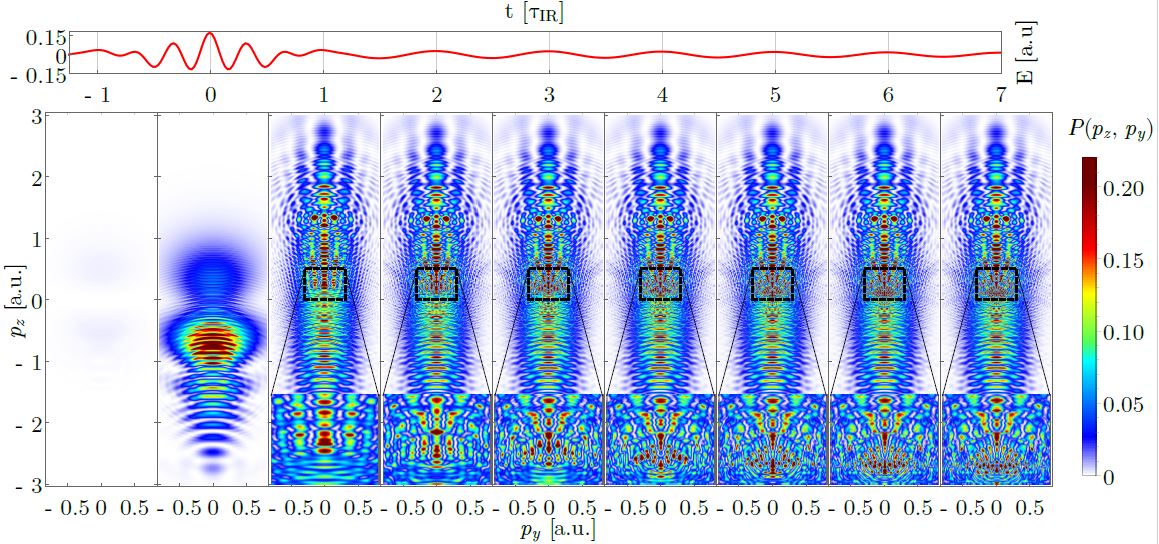Physics on the attosecond and nanometric scale
Our motivations are nicely explained by words of Richard Feynman taken from his famous "There is Plenty of Room at the Bottom": What are the possibilities of small but movable machines? They may or may not be useful, but they surely would be fun to make.
Roughly speaking, we select research topics that are intriguing and challenging for us. These include processes for which the characteristic time scale is attoseconds and the spatial scale is nanometers. At the moment, the focus of our interests are the interactions of atoms and molecules with strong, short laser pulses, which lead to the generation of high-harmonics or non-sequential ionization.
For example, the process of generating high-harmonics takes place as a result of the interaction of an atom/molecule /solid with a strong laser pulse, and the emitted light has frequencies that are multiples of the carrier wave frequency of the laser pulse. To add spice to the whole situation, they are multiples from the order of a few tens to the order of several hundreds of the frequency of the carrier wave (in special cases they can reach up to a thousand times). Using this phenomenon, it is possible to generate laser pulses with a carrier wave in the extreme ultraviolet and soft X-rays, which are attoseconds long. This, in turn, makes it possible to study phenomena occurring on a natural time scale for laser-induced processes. We investigate, for example, the influence of the presence of excited states or multi-electron processes on the phenomenon of high-harmonics generation. Moreover, we analyze the possibilities of controlling the properties of the generated harmonics with the use of many laser pulses or nanostructures with plasmonic properties. For this purpose, we are constantly developing our own software for quantum-mechanical calculations, confronting the results obtained with its use with the results of experiments available on the scientific market, the results of analytical calculations (when it is possible) and the results of calculations obtained under other models or numerical methods.
In addition, our interests include methods of data science and machine learning, which we would like to use to analyze images and spectra obtained with scanning probe microscopes, as well as to analyze the results obtained using our software for quantum-mechanical calculations.
If you have an interesting problem, it may be of interest to us as well. We are open to extensive cooperation. We have a lot of experience - we dealt with such distant topics as: quantum computing - entangled states, processes in strong laser fields, scanning probe microscopy, polymerization reactions on metal oxide surfaces, formation of organic nanostructures and surface functionalization, the application of physics to the conservation and restoration of works of art.

Recent papers
- Prauzner-Bechcicki JS, Zajac L, Olszowski P, Jöhr R, Hinaut A, Glatzel T, et al. Scanning probe microscopy studies on the adsorption of selected molecular dyes on titania. Beilstein Journal of Nanotechnology. 2016;7:1642-53.
- Efimov DK, Maksymov A, Prauzner-Bechcicki JS, Thiede JH, Eckhardt B, Chacón A, et al. Restricted-space ab initio models for double ionization by strong laser pulses. Phys Rev A. 2018;98(1): 013405.
- Thiede JH, Eckhardt B, Efimov DK, Prauzner-Bechcicki JS, Zakrzewski J. Ab initio study of time-dependent dynamics in strong-field triple ionization. Phys Rev A. 2018;98(3): 031401.
- Amini K, Biegert J, Calegari F, (…) Prauzner-Bechcicki J, (…) Lewenstein M. Symphony on strong field approximation. Rep. Prog. Phys. 2019, 82: 116001.
- Efimov DK, Prauzner-Bechcicki JS, Thiede JH, Eckhardt B, Zakrzewski J. Double ionization of a three-electron atom: Spin correlation effects. Phys Rev A. 2019, 100: 063408.
- Mandrysz M, Kubel M, Zakrzewski J, Prauzner-Bechcicki JS. Rescattering effects in streaking experiments of strong-field ionization. Phys Rev A. 2019, 100: 063410.
- Efimov DK, Prauzner-Bechcicki JS, Zakrzewski J. Strong-field ionization of atoms with p3 valence shell: Two versus three active electrons. Phys Rev A. 2020, 101: 063402.
- Woźniak AP, Lesiuk M, Przybytek M, Efimov DK, Prauzner-Bechcicki JS, (…), Moszyński R. A systematic construction of Gaussian basis sets for the description of laser field ionization and high-harmonic generation. The Journal of Chemical Physics. 2021, 154: 094111.
- Prauzner-Bechcicki JS, Efimov DK, Mandrysz M, Zakrzewski J. Strong-field triple ionization of atoms with p3 valence shell. J. Phys. B. 2021
- Efimov DK, Maksymov A, Ciappina M, Prauzner-Bechcicki JS, Lewenstein M, Zakrzewski J. Three-electron correlations in strong laser field ionization. Optics Express 29, 26526 (2021)
- Jiang H, Efimov DK, He F, Prauzner-Bechcicki JS. Dalitz plots as a tool to resolve nonsequential paths in strong-field triple ionization. Phys. Rev. A 105, 053119 (2022)
Group members
- dr hab. Jakub S. Prauzner-Bechcicki - Head
Contact
 Dr hab. Jakub S. Prauzner-Bechcicki
Dr hab. Jakub S. Prauzner-Bechcickiroom: B-1-10
phone: 12 664 45 85
email: jakub.prauzner-bechcicki@uj.edu.pl